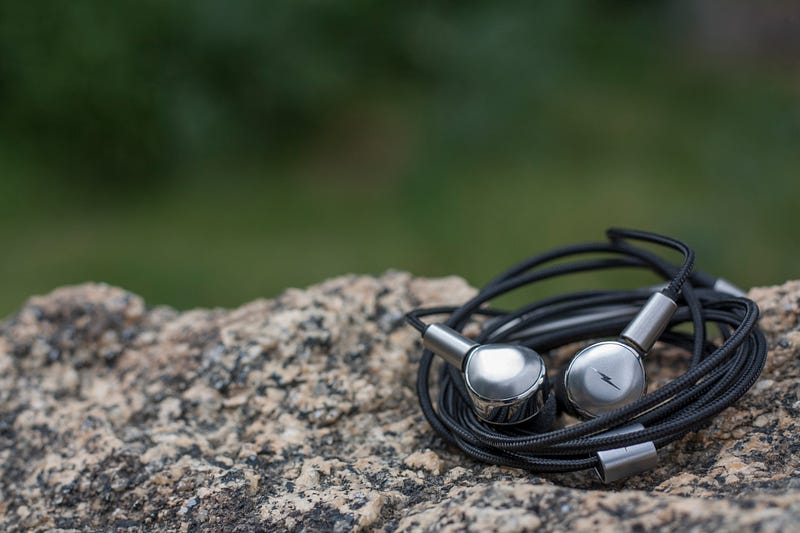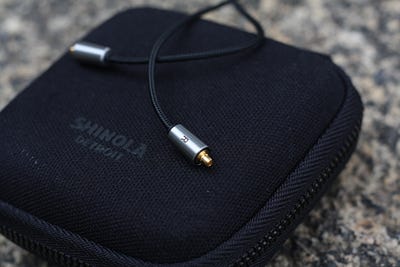
The Canfield IEM is a new product by Shinola, a luxury watchmaker based in Detroit. They’ve partnered with Campfire Audio to build class-leading luxury IEMs that are built to last, and look as good as they sound. Such a partnership seems only natural to me; the visual design expertise of a watch manufacturer combined with the audio know-how of Campfire Audio is a powerful combo. So then, how did this collaboration turn out? It’s beautiful to say the last. But does the Canfield IEM’s form really match its function?
The Canfield IEM can be bought here for $195. It is available in two colors: silver and black.
About My Preferences: Heads up, I’m a person! As such, these words are my opinion, and they are tinged by my personal preferences. While I try to mitigate this as much as possible during my review process, I’d be lying if I said my biases are completely erased. So for you, my readers, keep this in mind:
- My ideal sound signature would be an extended sub-bass with a leveled, but textured, mid-bass.
- I have a mild treble sensitivity.
HTC U11 -> Zorloo ZuperDAC-S-> earphones
or
Hidizs AP100 3.5mm out -> FiiO A5 3.5mm out -> earphones
or
HiFiMAN SuperMini -> earphones
or
PC optical out -> HiFiMe SPDIF 9018 Sabre DAC 3.5mm out -> earphones
All music was served as MP3 @320Kbps or as FLAC. The Canfield IEM sounded best with my Zorloo Zuper DAC-S.
Tech Specs
- Transducer Type: 8.5mm Beryllium dynamic driver
- Frequency Response: 10HZ — 20K
- THD: < 1%
- Impedance: 16.5Ω @ 1KHZ
- Sound Pressure Level: 104 DB
Sonic Overview:
The Canfield IEM features a mellow sound signature. It has a warm midrange and extended bass. The treble is less emphasized than it would be in a V-shaped sound signature. The upper midrange has a couple of very clean boosts to add clarity.
Treble: Songs used: In One Ear, Midnight City, Outlands, Satisfy, Little One
The Canfield IEM’s treble is its most divisive sonic feature. It doesn’t have the highly boosted treble that many “audiophile grade” IEMs do. As such, to ears most used to such sound signatures, it will sound dull and flat — though giving yourself a chance to adapt will change that. I often preach the importance of giving yourself time to adjust to a new earphone before passing judgment on it, and the Canfield IEM is a great reminder of the importance of such a habit. How so? Well, put plainly, it’s treble is well-toned and highly resolving, even if it isn’t particularly pronounced; something that isn’t particularly apparent at first.
The treble can pick up some very subtle details in the background of a song pretty good at resolving treble-bound details during complex parts of a song. The subtle breathing and amp buzz within In One Ear were audible and distinct.
The Canfield IEM’s treble has a tone of sweetness. You don’t often come across an IEM with a warm, smooth, and mellow sound signature that also has a sweet treble. I never heard it lose this quality either; it’s extremely consistent across mastering styles. And if you are a stickler for more pronounced treble, you can easily add 3dB of treble back into the sound signature with minimal disruption to its tonality through an EQ.
Midrange: Songs used: Flagpole Sitta, Jacked Up, I Am The Highway, Dreams, Too Close, Little Black Submarines
The Canfield IEM really shines with its midrange. It is comfortably warm and smooth. It’s lower midrange is boosted a bit past the upper midrange, though this doesn’t stop instrumentation and vocals from being very well articulated. The Canfield IEM presents itself with a level of refinement that’s rarely found at this price. Partnering with Campfire Audio clearly paid off!
The strumming of guitars is captivatingly textured. Each striking of the strings is maturely articulated. Both acoustic and electric guitars take on a life-like tonality that outdoes many of the Canfield IEM’s V-shaped peers. This is mainly an artifact of its outstanding instrumental separation in the midrange. Any airy presentation aided by the Canfield IEMs resolving treble complements the warm and otherwise laid-back nature of the sound signature.
The Canfield IEM prefers male vocals to female vocals. They are well weighted and full, capable of resolving complex inflections and resonations. Female vocals have a certain sweetness to them, but ultimately sound somewhat thin.
Bass: Songs used: Moth, Gold Dust, In For The Kill (Skream Remix), War Pigs (Celldweller Remix)
The Canfield IEM has a comparatively mild bass response. It bucks the trend of large mid-bass humps, instead, implementing a more linear bass signature that maintains a good amount of impact without creating any disturbances in the otherwise realistic and mellow tonality of the greater sound signature. It can deliver some rumble even at lower volumes and does so quite satisfyingly. The bass’s synergy between the mid-bass and sub-bass is very good.
Bass articulation is good as well. The Canfield IEM handled the sonorous bass-line of In For The Kill admirably, never losing solidity or bottoming out. The Canfield IEM is also quite good at resolving subtle bass-guitar riffs in the background. Consistent solidity and separation aids genres like metal and rock, giving them the well-defined lower-registers that they often times need.
Bass-heads will want something with more oomph, though. You can add more impact and rumble via an EQ. While this does work well for 2–3dB, adding any more sub-bass causes the sound signature to lose cohesion and solidity.
Packaging / Unboxing


Construction Quality








As an interesting side note: the Canfield IEM’s mid-housing’s metal feels and looks quite similar to the Campfire Comet’s metal. If they are indeed the same material they should age just like a stainless-steel watch would, at least according to Ken Ball from Campfire Audio. So rather than some faux paint-job chipping or dulling, you’ll get a refined “weathered” look.
Comfort
The Canfield IEM exceedingly comfortable. While weighty in the hand, the Canfield IEM’s mass is negligible once put in the ear. Shinola intended for this IEM to be worn cable-down, and as such, the microphone is placed for optimal performance in that orientation. While using the stock MMCX cable, it isn’t really possible to wear it over-ear. For that, you’ll need to go with the Canfield IEM Pro, Shinola’s quad-driver IEM.
Accessories

- 1x semi-hard carrying case
- 3x extra pairs of silicone eartips
- 1x pair of foam eartips
Internally, there is plenty of space for the IEM and its cable. You can even fit a USB-C or small Bluetooth adapter in there if you want. I could squeeze the Nexum Aqua+ into it.
Comparisons
1: Chord & Major 8'13 ($180)
The 8'13 is very different from the Canfield IEM. The Canfield IEM has a more forward and warm midrange, while the 8'13 has a more pronounced treble. They have similar mid-bass and sub-bass responses. The 8'13 is, as such, a proper V-shaped IEM that caters more to rock and metal, while the Canfield IEM is a warm IEM that plays no favorites; it’s a jack of all trades.
2: Simgot EN700 Bass ($125)
The EN700 Bass has a similar lower-end response to the Canfield IEM. It also features a more linear midrange that is colder than the Canfield IEM’s. After spending a couple days listening to the Canfield, the EN700 bass sounds comparatively grainy, succumbing to the absolute smoothness of the Canfield’s sound signature. It has similar detail retrieval in the treble but loses to the Canfield IEM in midrange detail retrieval. The two IEMs are closely matched in terms of bass retrieval. The Canfield IEM to have a more appealing sound signature, though. This is just personal preference, but I find it to be much more satisfying than the comparatively clinical EN700 Bass.
Summary
The Canfield IEM is a remarkable offering. It comes from a watch company but has been co-developed by Campfire Audio. Minds and hands from Portland and Detroit collaborated to pull off something only they could: an IEM with the audio know-how of an audiophile industry leader and the fashion sense of a burgeoning accessory maker. With a class-leading construction and compelling sound signature, the Canfield IEM is a giant among its peers, at least for those who like warm sound signatures. If you fall in that camp, go listen to it. Seriously. It’s great.
As always, happy listening!

